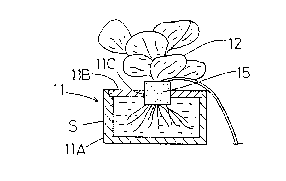Une partie des informations de ce site Web a été fournie par des sources externes. Le gouvernement du Canada n'assume aucune responsabilité concernant la précision, l'actualité ou la fiabilité des informations fournies par les sources externes. Les utilisateurs qui désirent employer cette information devraient consulter directement la source des informations. Le contenu fourni par les sources externes n'est pas assujetti aux exigences sur les langues officielles, la protection des renseignements personnels et l'accessibilité.
L'apparition de différences dans le texte et l'image des Revendications et de l'Abrégé dépend du moment auquel le document est publié. Les textes des Revendications et de l'Abrégé sont affichés :
| (12) Demande de brevet: | (11) CA 2148906 |
|---|---|
| (54) Titre français: | METHODE POUR CULTIVER DE JEUNES PLANTS |
| (54) Titre anglais: | A METHOD FOR RAISING SEEDLING |
| Statut: | Réputée abandonnée et au-delà du délai pour le rétablissement - en attente de la réponse à l’avis de communication rejetée |
| (51) Classification internationale des brevets (CIB): |
|
|---|---|
| (72) Inventeurs : |
|
| (73) Titulaires : |
|
| (71) Demandeurs : |
|
| (74) Agent: | KIRBY EADES GALE BAKER |
| (74) Co-agent: | |
| (45) Délivré: | |
| (86) Date de dépôt PCT: | 1994-09-08 |
| (87) Mise à la disponibilité du public: | 1995-03-16 |
| Licence disponible: | S.O. |
| Cédé au domaine public: | S.O. |
| (25) Langue des documents déposés: | Anglais |
| Traité de coopération en matière de brevets (PCT): | Oui |
|---|---|
| (86) Numéro de la demande PCT: | PCT/JP1994/001490 |
| (87) Numéro de publication internationale PCT: | JP1994001490 |
| (85) Entrée nationale: | 1995-05-08 |
| (30) Données de priorité de la demande: | ||||||
|---|---|---|---|---|---|---|
|
Cette invention permet de faire pousser efficacement une plante telle que la fraise depuis les stolons à partir desquels les jeunes plants seront récoltés. Cette invention concerne accessoirement un procédé de cueillette de ces jeunes plants. Ce procédé utilise une planche de culture surélevée où plusieurs stolons poussent en retombant de la plante mère plantée dans la planche de culture. Des éléments absorbant l'eau sont fixés sur les parties de racinement aérien à la jointure des stolons. L'eau est dispérsée en pluie dans l'air au-dessus des éléments absorbant l'eau pour que les parties de racinement prennent racine, ce qui permet aux jeunes plants de pousser. Les stolons sont ensuite coupés en l'air au niveau des points qui sont en face et en arrière des jeunes plants, ce qui constitue la cueillette des jeunes plants.
[ABSTRACT]
The object of the present invention is to clip and
collect seedlings easily and effectively from runners
of a parent plant such as strawberry. To attain this
object, a method for raising seedlings comprising;
planting a parent plant in a plant bed disposed in a
high position, growing plural runners linked mutually
to hang from said parent plan-t in said plant bed,
attaching water absorbing block to each rooting part
between runners hanging in midair, supplying water to
each water block to grow root and seedling from said
rooting part, and clipping and collecting the resulting
seedlings from runners is provided.
- 8 -
Note : Les revendications sont présentées dans la langue officielle dans laquelle elles ont été soumises.
Note : Les descriptions sont présentées dans la langue officielle dans laquelle elles ont été soumises.

2024-08-01 : Dans le cadre de la transition vers les Brevets de nouvelle génération (BNG), la base de données sur les brevets canadiens (BDBC) contient désormais un Historique d'événement plus détaillé, qui reproduit le Journal des événements de notre nouvelle solution interne.
Veuillez noter que les événements débutant par « Inactive : » se réfèrent à des événements qui ne sont plus utilisés dans notre nouvelle solution interne.
Pour une meilleure compréhension de l'état de la demande ou brevet qui figure sur cette page, la rubrique Mise en garde , et les descriptions de Brevet , Historique d'événement , Taxes périodiques et Historique des paiements devraient être consultées.
| Description | Date |
|---|---|
| Inactive : CIB expirée | 2018-01-01 |
| Inactive : CIB expirée | 2018-01-01 |
| Inactive : CIB de MCD | 2006-03-11 |
| Demande non rétablie avant l'échéance | 1997-09-08 |
| Le délai pour l'annulation est expiré | 1997-09-08 |
| Réputée abandonnée - omission de répondre à un avis sur les taxes pour le maintien en état | 1996-09-09 |
| Demande publiée (accessible au public) | 1995-03-16 |
| Date d'abandonnement | Raison | Date de rétablissement |
|---|---|---|
| 1996-09-09 |
Les titulaires actuels et antérieures au dossier sont affichés en ordre alphabétique.
| Titulaires actuels au dossier |
|---|
| M-HYDROPONICS RESEARCH CO., LTD. |
| Titulaires antérieures au dossier |
|---|
| SHINJI MURAI |
| YOSHIMI ABE |